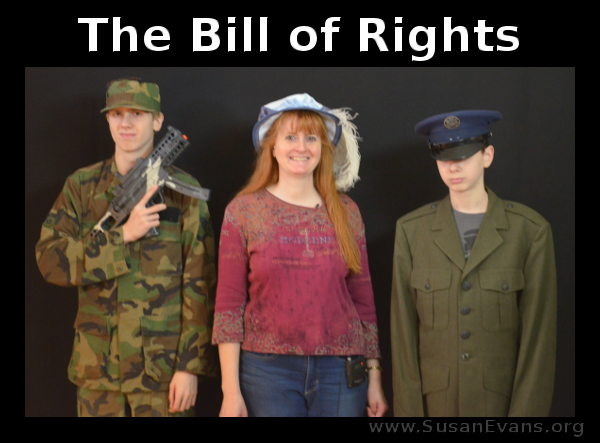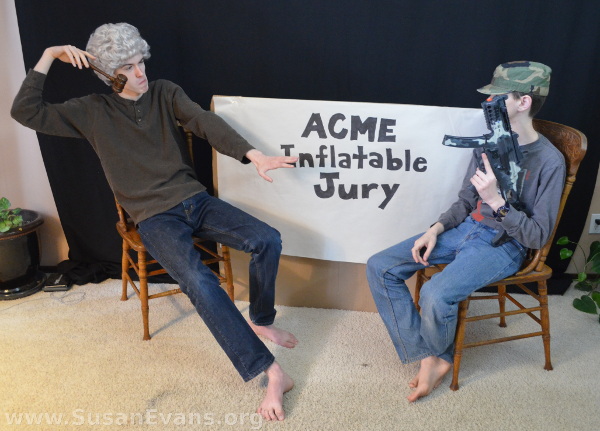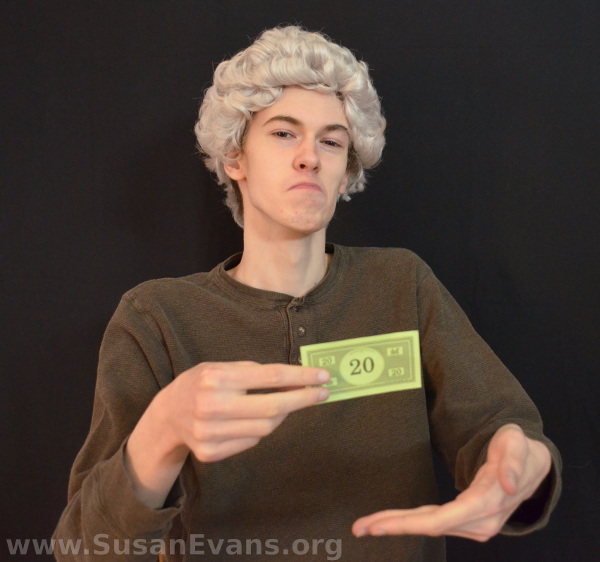Today we will be dramatizing the Bill of Rights, the first ten amendments of the United States Constitution. These are our cherished freedoms as human beings, so they are quite important. The Notgrass Company has sponsored the furtherance of these fun and exciting blog posts, since we are basing our study completely on their Exploring Government book, which has made our learning of high school government a pleasure!
Without further ado, we present to you our next installment in our government series, to familiarize you with the Bill of Rights. Feel free to perform these skits in your own homeschool co-ops and/or schools.
The Bill of Rights Dramatized
Amendment I:
Congress shall make no law respecting an establishment of religion, or prohibiting the free exercise thereof; or abridging the freedom of speech, or of the press; or the right of the people peaceably to assemble, and to petition the Government for a redress of grievances.
(One person is praying, one is speaking, and one is reading comics. After a bit, they gather together.)
Amendment II:
A well regulated Militia, being necessary to the security of a free State, the right of the people to keep and bear Arms, shall not be infringed.
(One person bares his arm literally; another is holding a gun.)
Amendment III:
No soldier shall, in time of peace be quartered in any house, without the consent of the Owner, nor in time of war, but in a manner to be prescribed by law.
(A soldier walks into a woman’s house. She points at him to get out, and he leaves.)
Amendment IV:
The right of the people to be secure in their persons, houses, papers, and effects, against unreasonable searches and seizures, shall not be violated, and no Warrants shall issue, but upon probable cause, supported by Oath or affirmation, and particularly describing the place to be searched, and the persons or things to be seized.
(One person holds lots of stuff. A police officer tries to take her stuff; another officer pulls him away and reprimands him.)
Amendment V:
No person shall be held to answer for a capital, or otherwise infamous crime, unless on a presentment or indictment of a Grand Jury, except in cases arising in the land or naval forces, or in the Militia, when in actual service in time of War or public danger; nor shall any person be subject for the same offense to be twice put in jeopardy of life or limb; nor shall be compelled in any criminal case to be a witness against himself, nor be deprived of life, liberty, or property, without due process of law; nor shall private property be taken for public use, without just compensation.
(A trial scene where the jury gives an “indictment” to the judge. Defendant puts on a military hat and jury takes “indictment” away. One person sits in a chair across from a judge. Judge convicts the person, then someone else holds up “x2” crossed out.)
Amendment VI:
In all criminal prosecutions, the accused shall enjoy the right to a speedy and public trial, by an impartial jury of the State and district wherein the crime shall have been committed, which district shall have been previously ascertained by law, and to be informed of the nature and cause of the accusation; to be confronted with the witnesses against him; to have compulsory process for obtaining witnesses in his favor, and to have the Assistance of Counsel for his defense.
(A trial scene rushes together quickly: the prosecution brings out witnesses, then the defense also brings out witnesses.)
Amendment VII:
In Suits at common law, where the value in controversy shall exceed twenty dollars, the right of trial by jury shall be preserved, and no fact tried by a jury shall be otherwise re-examined in any Court of the United States, than according to the rules of common law.
(A trial scene with the jury bouncing around to draw attention to the fact that it’s there.)
Amendment VIII:
Excessive bail shall not be required, nor excessive fines imposed, nor cruel and unusual punishments inflicted.
(Lots of money is shown, then a “cruel and unusual punishment” is inflicted in the form of tickling someone with a feather.)
Amendment IX:
The enumeration in the Constitution, of certain rights, shall not be construed to deny or disparage others retained by the people.
(One person acts really important; another person is drooping because he doesn’t feel important. Someone reprimands the important person for looking down on other people.)
Amendment X:
The powers not delegated to the United States by the Constitution, nor prohibited by it to the States, are reserved to the States respectively, or to the people.
(Three people wear labels “Government,” State,” and “People.” One person gives “Rights” to the Government, then stops and gives it to “People.”)
I hope you enjoyed our re-enactment of the Bill of Rights. Stay tuned for the next episode: Make Your Own State Tourism Brochures
The links in this series of blog posts are not affiliate links. Please buy the book from their website to bless their family the most!
Tags: American government, Constitution, government, hands-on learning, high school, history, Notgrass







What a cool way to study government. I can’t wait till we get to US History.
Thanks! We’ve been having a great time studying Government by re-enacting so many concepts!
Your kids are such good sports with these videos! I wish my kids would do something like this! We really enjoy watching all of yours though!
So glad you are enjoying our government series!
What great videos and a super fun learning tool. I wish I would have thought of this when we were homeschooling. Thanks for sharing. – Amy
I’m glad you are enjoying this video series! I created it to help other high school students learn about Government from a Christian perspective.
You are a real teacher at heart. You jump right in there with your kids and create memorable learning experiences!
Thank you; we have a lot of fun together. I’ve always loved homeschooling because my kids are all with me, excited about learning.
I wish we did videos like this in school. I would’ve retained a lot more information lol!
You definitely retain a lot more information when you re-enact a concept!
What a way to make learning fun!
Learning ought to be fun!
This looks like a really fun way to learn History
This is definitely a fun way to learn!
This looks like such a fun way to learn an otherwise boring topic! Thanks for the inspiration!
Who knew Government needn’t be boring?
I am fairly certain your children know more about American history than 80% of the average population! Good job mom!
That’s probably true…
This is awesome, I wish we’d done this in high school or middle school! I also love that the cruel and unusual punishment was tickling with a feather, because being tickled is my absolute least favorite thing.
My kids came up with that feather tickling idea. I thought it was hilarious!
This is why we homeschool! Just to dive in to important things in creative and memorable ways.